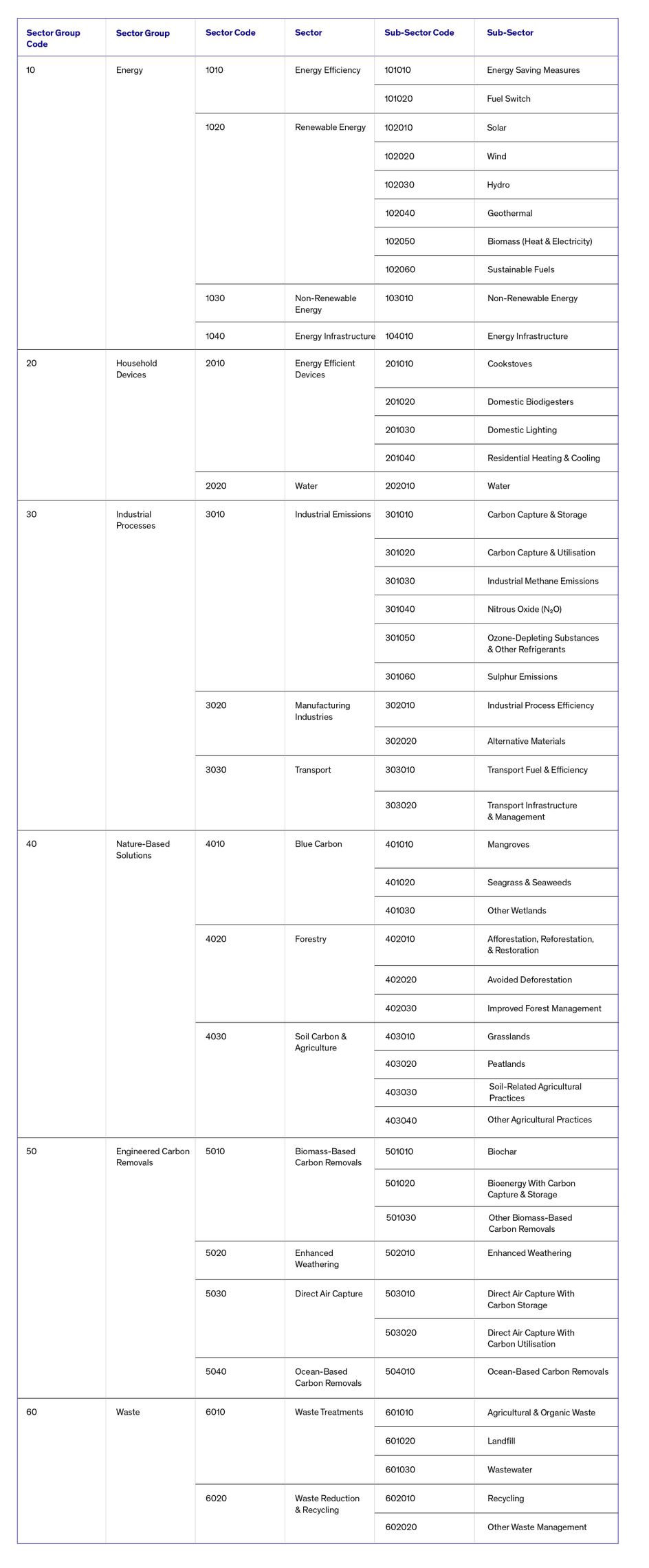
Introducing Version 2.0 of the BeZero Sector Classification
Contents
- Introducing Version 2.0 of the BeZero Sector Classification
- Improving Granularity for Renewables
- Comprehensive Coverage of Carbon Removals
Introducing Version 2.0 of the BeZero Sector Classification
The voluntary carbon market (VCM) is beginning to scale but lacks the critical information infrastructure to allow capital to circulate freely. As is the case with financial markets, sector classification - a system that labels projects based on the category that the majority of its carbon credit issuance contributes to - is a critical tool in understanding, analysing and trading in this new market.
Sector classifications across the VCM are inconsistent, with over 90 defined sectors across the five major standards bodies. Inconsistencies across global registries include the number and names of sectors and sub-sectors covered, the downstream labelling of projects, and the identification of credits as removal or avoidance.
BeZero Carbon has developed the BeZero Sector Classification System to provide the VCM with a standardised, simple, data-driven, and reliable tool to use while participating in this market. The BeZero Sector Classification System is applicable across all project types - from renewables to nature-based solutions - and has recently been updated to better reflect the current trajectory of the VCM. The updated structure is listed below. A set of definitions, alongside a full methodology document, can be found here.

Table 1: The BeZero Sector Classification System (Version 2.0)
Improving Granularity for Renewables
Version 2.0 of the BeZero Sector Classification System provides further granularity between sub-sectors, for example by including the specific type of renewable energy in the Renewables sector - Solar, Wind, Hydro, Geothermal, and Biomass (for Heat & Electricity). This will allow users to easily differentiate between technology types that each comprise a significant proportion of the VCM. These different technology types have their own nuances which may align with the preferences of stakeholders or impact a project’s BeZero Carbon Rating. Figures 1 and 2 show the spread of rated renewable energy projects under Version 1.3 and Version 2.0 of the BeZero Sector Classification System respectively.

Figure 1: BeZero-rated Renewable Energy projects under Version 1.3 of the BeZero Sector Classification System

Figure 2: BeZero-rated Renewable Energy projects split by technology type under Version 2.0 of the BeZero Sector Classification System
This improved granularity allows our customers to perform additional levels of analysis on our ratings. For example, as of Jul 1, 2023, BeZero has rated three Renewable Energy projects in Vietnam, one of which is rated as ‘BBB’ and two of which are rated as ‘B’, meaning that BeZero believes that the issued credits have a moderate and low likelihood of delivering a tonne of carbon avoided respectively. The ‘BBB’-rated project is a wind project, whereas the two ‘B’-rated projects are hydro, as shown below.

Figure 3: BeZero-Rated Renewable Project in Vietnam Split by Technology Type
The full analysis for each of these projects is available on the BeZero Carbon Markets platform. However, part of the explanation for this distinction is that hydropower is well-established in Vietnam, with several government policies specifically prioritising small hydropower stations as part of a strategy to develop the country’s electricity industry. This presents significant additionality and notable policy risks, as the carbon efficacy of such projects is put into question. On the other hand, wind power is still relatively new to the country and is not explicitly mentioned in national policies and targets, suggesting that carbon finance may play a larger role in promoting the implementation of wind projects in the country compared to hydropower projects.
Comprehensive Coverage of Carbon Removals
In addition to a further level of granularity, the updated BeZero Sector Classification System includes more comprehensive coverage of emerging sectors within the market, including engineered carbon dioxide removals. BeZero defines Engineered Carbon Removals as engineered technical solutions that enhance or facilitate the removal of greenhouse gases from the atmosphere. The table below details how these credits differ from Carbon-Capture & Storage.

Table 2: Distinction between Engineered Carbon Removals and Carbon-Capture & Storage
The Intergovernmental Panel on Climate Change now recognises carbon removals as critical in order to achieve a global net-zero scenario, and will need to achieve a rate of 4-10 gigatonnes CO2e per year by 2050 in order to be aligned with a Paris Agreement temperature goal. Engineered Carbon Removals currently accounts for less than 0.1% of current carbon removal, with the vast majority coming from Nature-Based Solutions. 1,2
However, with recent developments in carbon removal technology, this fraction is expected to increase. The updated BeZero Sector Classification System better represents this emerging area of the VCM, including Biomass-based Carbon Removals, Enhanced Weathering, Direct Air Capture, and Ocean-Based Carbon Removals, which are defined in the table below. Such coverage will be particularly salient as we increasingly engage with the primary market through our ex ante rating.

Table 3: Types of engineered carbon removal covered in the BeZero Sector Classification System
In terms of scale, an estimated 961 tCO2e has already been removed via key carbon removal technologies, yet 6.3 MtCO2e of removals have been purchased to date, as shown in the following figures.


Figure 4 and 5: The delivered and purchased tonnes of carbon from various engineered carbon removal technologies, based on data from cdr.fyi
The BeZero Sector Classification System is a critical tool - both now and moving forward - to help VCM stakeholders categorise a complex and evolving market.
If you are interested in using the BeZero Sector Classification System, please reach out to our commercial team.
References:
1 PCC AR6 SYR (https://report.ipcc.ch/ar6syr/pdf/IPCC_AR6_SYR_SPM.pdf)
2 Smith, S. M., Geden, O., Nemet, G., Gidden, M., Lamb, W. F., Powis, C., Bellamy, R., Callaghan, M., Cowie, A., Cox, E., Fuss, S., Gasser, T., Grassi, G., Greene, J., Lück, S., Mohan, A., Müller-Hansen, F., Peters, G., Pratama, Y., Repke, T., Riahi, K., Schenuit, F., Steinhauser, J., Strefler, J., Valenzuela, J. M., and Minx, J. C. (2023). The State of Carbon Dioxide Removal - 1st Edition. The State of Carbon Dioxide Removal. doi:10.17605/OSF.IO/W3B4Z